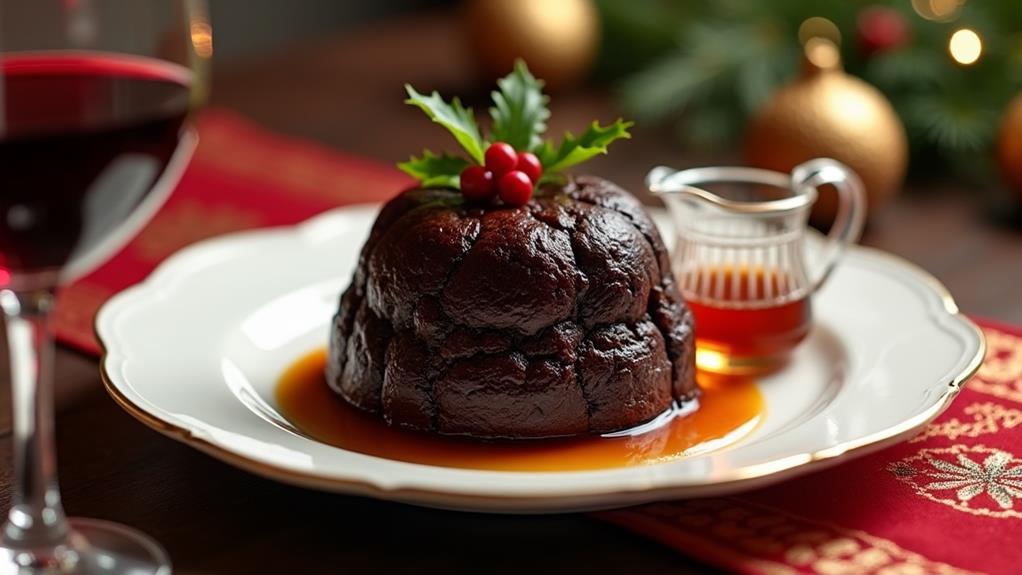You've likely heard of traditional carbonara, but have you encountered Gennaro Contaldo's asparagus twist on this classic Roman dish? This innovative recipe combines the creamy, indulgent flavors of carbonara with the fresh, vibrant notes of seasonal asparagus. It's a perfect example of how Italian cuisine can evolve while staying true to its roots. As you consider trying this dish, you might wonder about its origins, the exact recipe, or the best techniques for achieving that perfect silky sauce. There's more to this seemingly simple pasta than meets the eye, and it's worth exploring further.
Key Takeaways
- Gennaro Contaldo's recipe combines traditional carbonara with fresh asparagus for a modern twist on Italian cuisine.
- The dish features spaghetti, asparagus, eggs, Pecorino Romano cheese, and pancetta as its main ingredients.
- Cooking involves boiling pasta, whisking eggs with cheese, and sautéing pancetta and asparagus before combining all components.
- The sauce's consistency is crucial, achieved by gradually adding reserved pasta water while vigorously tossing the ingredients.
- This recipe demonstrates the evolution of classic Italian dishes, incorporating seasonal vegetables into time-honored preparations.
History
While traditional carbonara has a long history in Italian cuisine, the asparagus variation is a relatively recent innovation.
You'll find that the classic carbonara, originating in Rome, typically features eggs, hard cheese, cured pork, and black pepper. This beloved dish gained popularity in the mid-20th century, becoming a staple of Roman cuisine.
The addition of asparagus to carbonara is a modern twist, reflecting the evolving nature of Italian cooking. You're experiencing a fusion of traditional techniques with contemporary ingredients, showcasing the adaptability of Italian cuisine.
This variation likely emerged as chefs sought to incorporate seasonal vegetables into classic recipes, adding a fresh element to the rich, creamy pasta dish.
While purists might argue that adding asparagus deviates from the authentic carbonara, you'll find that many Italian chefs, including Gennaro Contaldo, embrace such innovations.
They recognize the value in reimagining traditional dishes to suit modern tastes and dietary preferences. By incorporating asparagus, you're participating in the ongoing evolution of Italian cuisine, which continues to adapt and inspire food lovers worldwide.
Recipe
Asparagus Carbonara is a delightful twist on the classic Roman pasta dish, incorporating the fresh, vibrant flavors of asparagus into the rich, creamy carbonara sauce. This variation, inspired by renowned Italian chef Gennaro Contaldo, offers a perfect balance of crisp asparagus, salty pancetta, and creamy eggs that complement the al dente pasta.
By limiting the recipe to just five ingredients, we've streamlined the cooking process while maintaining the essence of this beloved Italian dish. The result is a harmonious blend of flavors that celebrates the simplicity and elegance of Italian cuisine.
- 1 pound (450g) spaghetti
- 1 bunch asparagus, trimmed and cut into 1-inch pieces
- 4 large eggs
- 1 cup (100g) grated Pecorino Romano cheese
- 4 ounces (115g) diced pancetta
Bring a large pot of salted water to a boil and cook the spaghetti according to package instructions until al dente. In a large bowl, whisk together the eggs and grated Pecorino Romano cheese.
In a separate pan, cook the pancetta until crispy, then add the asparagus and sauté until tender-crisp. When the pasta is ready, reserve 1 cup of pasta water, then drain the spaghetti and immediately add it to the egg mixture, tossing quickly to coat the pasta and create a creamy sauce.
Add the pancetta and asparagus to the pasta, along with a splash of the reserved pasta water if needed to achieve the desired consistency. Serve immediately.
For the best results, ensure that your eggs are at room temperature before whisking them with the cheese. This will help create a smoother sauce and prevent the eggs from scrambling when mixed with the hot pasta.
Additionally, be sure to work quickly when combining the hot pasta with the egg mixture to achieve the signature silky texture of carbonara. If the sauce becomes too thick, gradually add small amounts of the reserved pasta water until you reach the desired consistency.
Cooking Steps
To prepare this delicious Asparagus Carbonara, you'll start by boiling water for the pasta and whisking together eggs and cheese in a separate bowl.
While the pasta cooks, you'll sauté the pancetta and asparagus until crispy and tender-crisp, respectively.
Once the pasta is al dente, you'll quickly combine it with the egg mixture, creating a silky sauce, and then fold in the pancetta and asparagus, adding reserved pasta water as needed for the perfect consistency.
Step 1. Boil Water for Pasta
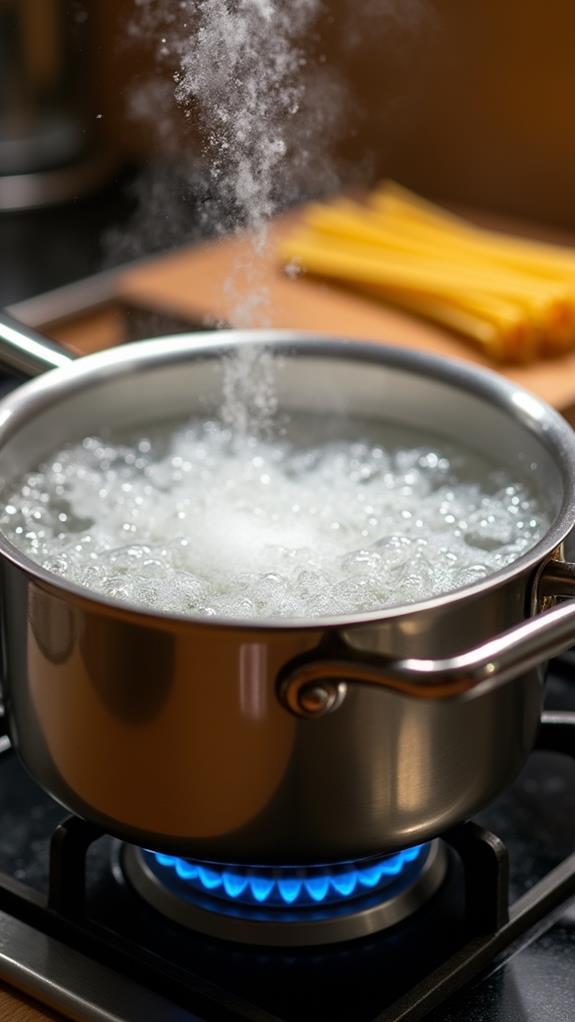
As you embark on preparing this delicious Asparagus Carbonara, the first step is to bring a large pot of water to a boil. Fill a spacious pot with cold water, ensuring there's enough room for the pasta to move freely as it cooks.
Place the pot on your stove's largest burner and turn the heat to high. While you're waiting for the water to boil, it's the perfect time to gather your other ingredients and prepare them.
Once you see large bubbles rapidly breaking the surface, it's time to add salt. Don't be shy with the salt; pasta water should taste like the sea. This step is crucial for flavoring the pasta from within as it cooks.
After adding the salt, give the water a quick stir to dissolve it. Now you're ready to add your spaghetti. As you lower the pasta into the boiling water, use a long utensil to push it down gently, ensuring it's fully submerged.
Set your timer according to the package instructions for al dente pasta, typically around 8-10 minutes.
Step 2. Whisk Eggs and Cheese
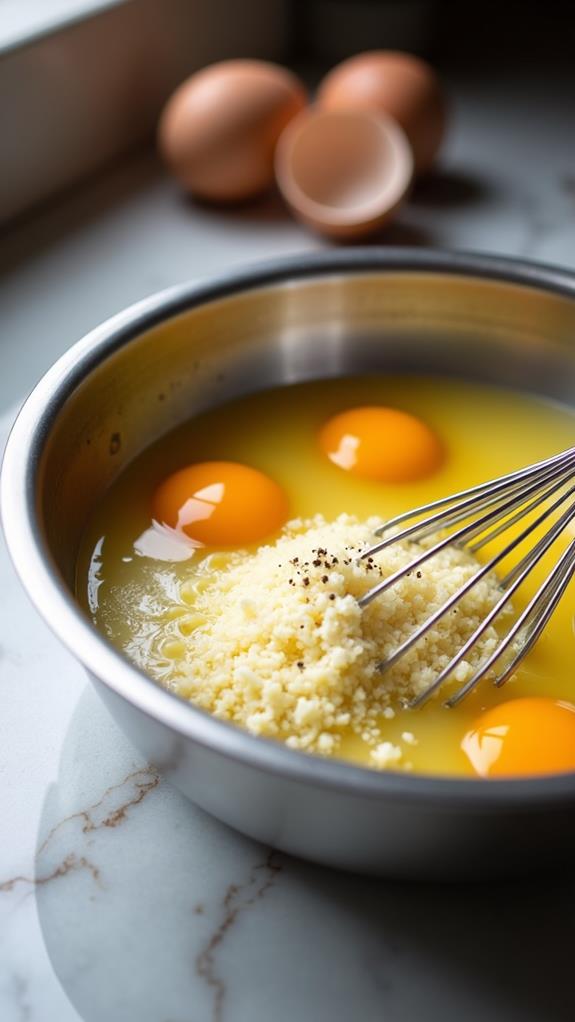
While your pasta water is coming to a boil, it's time to prepare the heart of your carbonara sauce. In a large bowl, crack four large eggs, ensuring no shell fragments fall in. Add one cup of freshly grated Pecorino Romano cheese to the eggs. Using a whisk or fork, beat the eggs and cheese together vigorously until they're well combined and slightly frothy. This mixture will create the creamy base of your carbonara sauce.
For the best results, make sure your eggs are at room temperature before whisking. This will help prevent them from curdling when they come into contact with the hot pasta later. If you've forgotten to take them out of the fridge earlier, you can quickly warm them by placing them in a bowl of lukewarm water for a few minutes.
As you whisk, you'll notice the mixture becoming smoother and more homogeneous. This is crucial for achieving that silky, velvety texture that carbonara is known for. Set this mixture aside, but keep it within reach, as you'll need it ready when your pasta is done cooking.
Step 3. Cook Pancetta and Asparagus
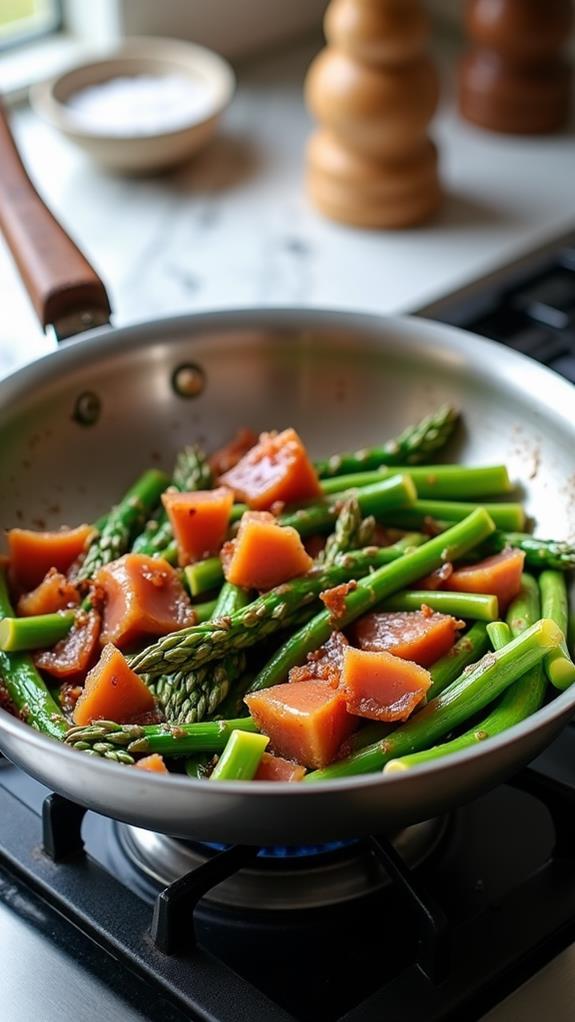
With your egg and cheese mixture prepared, it's time to focus on the pancetta and asparagus.
Begin by heating a large skillet over medium heat. Add the diced pancetta to the pan, allowing it to cook until it becomes crispy and golden brown, which should take about 5-7 minutes. Stir occasionally to ensure even cooking and prevent burning.
Once the pancetta is crisp, add the trimmed and cut asparagus pieces to the skillet.
Sauté the asparagus with the pancetta for 3-4 minutes, or until it becomes tender-crisp. You'll want the asparagus to retain some of its crunch while still being cooked through. The heat from the pan will help the asparagus release its natural flavors, which will mingle beautifully with the salty pancetta.
Keep a close eye on the pan during this process, as you don't want to overcook the asparagus. It should maintain its vibrant green color and a slight bite.
Once both the pancetta and asparagus are cooked to perfection, remove the skillet from the heat. You're now ready to combine these flavorful ingredients with your pasta and egg mixture to create the final dish.
Step 4. Combine Pasta With Egg Mixture
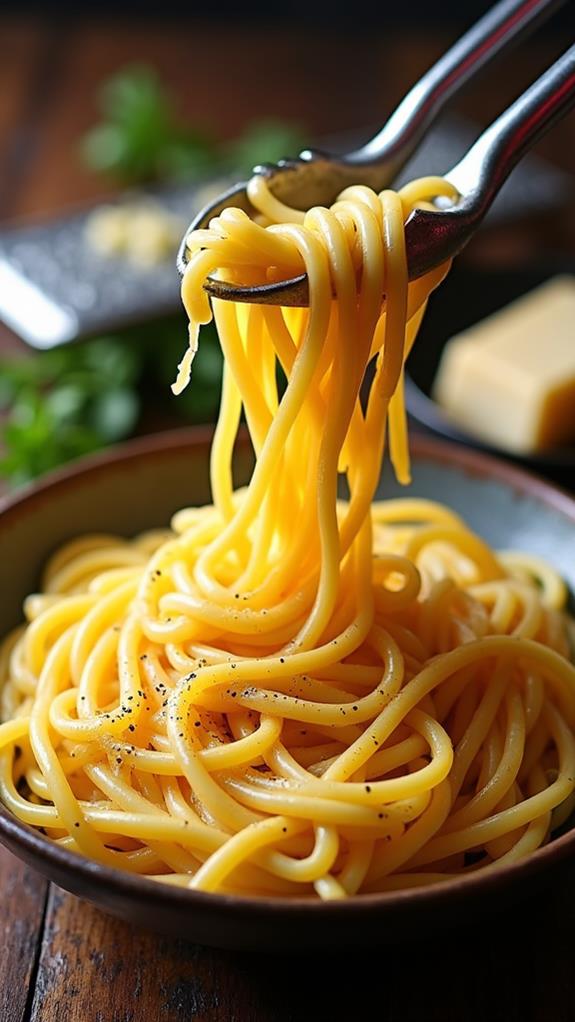
Ready to bring your Asparagus Carbonara together? Once your pasta is cooked al dente, it's time to create that signature creamy sauce.
Drain the spaghetti, but don't forget to reserve a cup of the starchy pasta water first. You'll need it to adjust the consistency later.
Now, work quickly to combine the hot pasta with the egg and cheese mixture. The residual heat from the pasta will gently cook the eggs, creating a silky sauce. Toss the spaghetti vigorously in the bowl, ensuring every strand is coated. If the sauce seems too thick, add a splash of the reserved pasta water to loosen it up.
Next, fold in your crispy pancetta and tender-crisp asparagus. The combination of textures and flavors will elevate your dish to new heights.
Keep tossing until everything is well distributed and the sauce clings to the pasta beautifully. Remember, timing is crucial here. You want to serve your Asparagus Carbonara immediately while it's still hot and creamy.
Your guests will be impressed by this delicious twist on a classic Italian favorite.
Step 5. Add Reserved Pasta Water
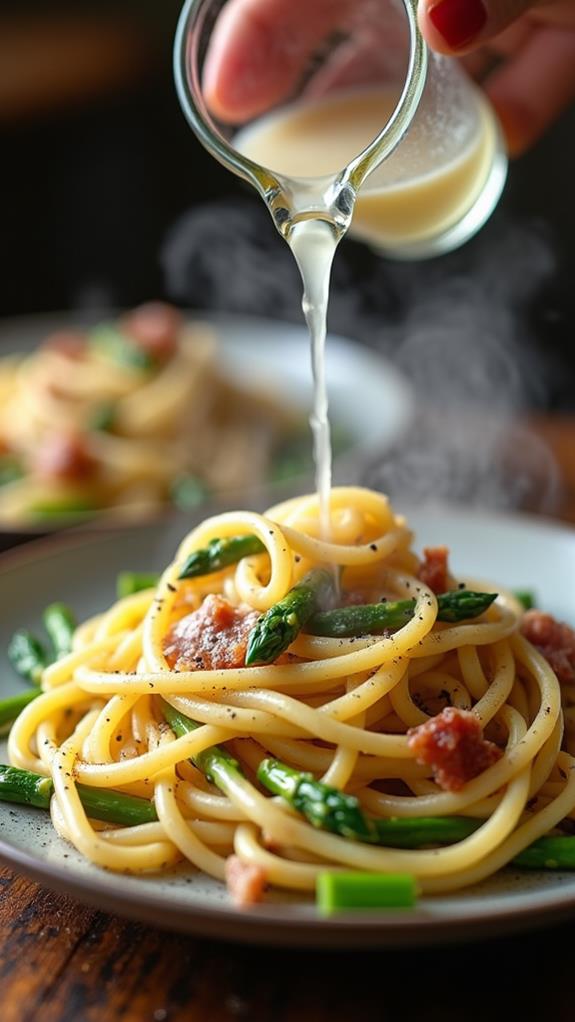
Now that you've combined the pasta with the egg mixture, it's time to perfect your Asparagus Carbonara's consistency. The reserved pasta water is your secret weapon for achieving the ideal texture.
If you find that your sauce is too thick or dry, don't panic. Gradually add small amounts of the reserved pasta water, about a tablespoon at a time, while continuously stirring the pasta. This process helps to thin out the sauce and create a silky, smooth texture that coats each strand of spaghetti perfectly.
As you add the pasta water, pay close attention to how the sauce clings to the noodles. You're aiming for a creamy consistency that's neither too thick nor too runny. Remember, the sauce will continue to thicken as it cools, so it's better to err on the side of slightly thinner rather than too thick.
Keep tossing the pasta with tongs or a large fork to ensure even distribution of the sauce. If you've added too much water, don't worry. Simply continue cooking the pasta over low heat, stirring constantly, until the excess liquid evaporates and you achieve the desired consistency.
Final Thoughts
This asparagus carbonara recipe offers a delightful twist on a classic Italian dish. You'll find that the crisp asparagus adds a fresh, spring-like flavor to the rich, creamy sauce.
As you prepare this meal, remember that timing is crucial. Have all your ingredients ready before you start cooking, as the process moves quickly once the pasta is done. Don't worry if your first attempt isn't perfect; carbonara takes practice to master.
The key is to work swiftly when combining the hot pasta with the egg mixture to create that silky texture without scrambling the eggs. If you're serving guests, consider garnishing with extra grated cheese and a sprinkle of black pepper for a restaurant-quality presentation.
This dish is best enjoyed immediately, so gather your diners before you start plating. With its balance of flavors and textures, you'll find that this asparagus carbonara is a crowd-pleaser that's sure to become a regular in your recipe rotation.
It's a testament to how a few simple ingredients can come together to create something truly special.



